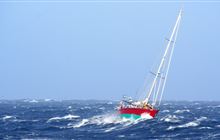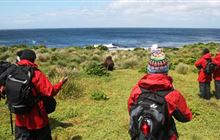Auckland Islands
Introduction
The Auckland Islands are the largest of New Zealand’s subantarctic islands with the richest flora, the largest number of subantarctic invertebrates and some of the rarest birds on earth.In this section
The Auckland Islands lie 465 km south of New Zealand’s South Island port of Bluff. They are the largest of New Zealand’s subantarctic islands, with a combined area of 57,000 ha. As well as having a wide variety of plants and wildlife they also have a rich human history.
The islands are of great cultural and spiritual significance to Ngāi Tahu. Traditions include stories of expeditions to the Auckland Islands to gather food and other natural resources, by Waitaha, Kāti Māmoe and Ngāi Tahu in succession. The story of Tama Rereti tells of a group of chiefs and tohunga who were the first to venture into the southern ocean, searching for the Aurora Australis. The islands are known to iwi both as Maungahuka (a name which may reference the white tips on mountainous waves in the surrounding seas) and Motu Maha.
The Auckland Islands Marine Mammal Sanctuary was established in 1993. The New Zealand Subantarctic Islands Area was designated a World Heritage Site in 1998 and the Auckland Islands - Motu Maha Marine Reserve was established in 2003.
Geography
View a map of the Auckland Islands.
The Auckland Islands are made up of the remains of two ancient volcanoes which have been subsequently cut by glaciers. The terrain is rugged and mountainous, with steep cliffs on the western and southern sides and deep valleys with long inlets to the east.
Auckland Island is the main island in the group. It is approx 40 km long and 12 km wide at its widest point and has an approximate land area of 46,000 ha.
The group includes many other smaller islands. The largest of these is 10,000 ha Adams Island, which lies south of the main island.
This is followed by 700 ha Enderby Island, 1km north of the main island, and Disappointment Island, 8 km west of the main island. All three of these outer islands are free of mammalian pests.
Seabirds
The Auckland Islands are important seabird breeding grounds. It is the strong hold of the rare yellow-eyed penguin, with a high proportion of the population breeding on Enderby Island.
Also most of the world's population of white capped mollymawk breed here (some 90–100,000 on Disappointment Island) along with Gibson's wandering albatross on Adams Island, the sooty shearwater and the endemic Auckland shag. There is also an abundance of albatrosses, penguins and petrels.
Land birds
The Auckland Island snipe, Auckland Island teal, Auckland rail and the tomtit are all endemic to the Auckland Islands. The red-fronted and yellow-crowned parakeets, tūī, New Zealand bellbird, New Zealand pipit, the Auckland Island dotterel (a larger race of the mainland banded dotterel) and the Auckland Island falcon (a race of the mainland species) all call the Auckland Islands home.
Invertebrates
The Auckland Islands have the largest number of subantarctic invertebrates of all New Zealand's subantarctic islands. There are over 280 insects, 95 of which are endemic (found nowhere else on Earth). The islands also boast an endemic genus and species of weta, Dendroplectron aucklandensis.
New Zealand sea lion
By the 21st century the Auckland Islands had become the primary breeding location of the New Zealand sea lion.
Plants
The Auckland Islands have the richest flora of the five island groups. 196 native species have been recorded.
The vegetation of the Auckland Islands subdivides by distinct altitudinal zones with the width of each changing as you get further south. In the salt spray zone there is often a herb turf. Above it, in exposed sites, you will find tussock land, with associated herbs. The only sizable dune area is Sandy Bay on Enderby Island.
Beyond the coastal zone, in more sheltered sites of the north and east, is a forest made up totally of southern rata (metrosideros) – the same species as in the South Island. The many twisted and gnarled stems of the rata give the forest a haunted atmosphere.
The soft tree fern also grows on the Auckland Islands – the most southern habitat for a tree fern.
Introduced mammalian pests
Animal pests introduced by humans over the last 200 years have inflicted severe ecological damage to the Auckland Islands.
Action to remove these pests began with the successful eradication of a small confined population of goats from the main Auckland Islands during 1989–1991. Next the cattle and rabbits were successfully eradicated from Enderby Island during 1991–93.
The main Auckland Island is the only New Zealand subantarctic island where mammalian pests remain, causing the following impacts:
- Pigs have devastated floral communities, restricting understorey regeneration, seabird survival and recruitment. They have grossly lowered vegetation biomass and damaged soils.
- Of the 44 bird species that breed in the archipelago, only 12 native species persist on Auckland Island.
- Pigs and cats have caused the local extinction of the rest of the bird species including the burrowing seabirds, majorly disrupting nutrient cycling.
- Mice have altered the abundance and composition of invertebrate fauna. They compete for food with native birds and pose a risk of future attacks on seabird chicks.
Following the successful eradication of mice from Antipodes Island, DOC is currently investigating the feasibility of eradicating pigs, cats and mice from Auckland Island to achieve mammalian pest-free status for the New Zealand Subantarctic Islands.
Maukahuka: Pest Free Auckland Island
History and culture
Discover the heritage sites in the Auckland Islands:
- Castaway Finger Posts guided shipwrecked sailors to castaway depots.
- Sandy Bay Boatshed was a lifeline for shipwrecked survivors to row to.
- Stella Hut is a surviving castaway depot.
- Enderby Settlement was an ill-fated planned settlement.
- Derry Castle is a grave site on Enderby Island.
- Second World War lookout huts was used to keep watch for enemy naval vessels.
- The expedition site where a rare sighting of Venus was recorded to measure Earth's distance from the sun.
Thirteenth century archaeological deposits on Enderby Island provide significant evidence of the southernmost extent of Polynesian Pacific voyaging and occupation found to date.
Captain Abraham Bristow was the first European visitor in 1806, leaving sealers and liberating pigs in 1807. More sealers followed in the 1820s, 1870s and 1880s before the species was protected in 1894.
In about 1842, chief Matiora from Ngāti Mutanga of Taranaki led a settlement of Māori and Mōriori. From 1849 to 1852 their fate became entwined with that of the Enderby Company settlers.
Multiple failed attempts at pastoralism followed. Dr Francis Monkton was first to stock a lease (1873), followed by John Moffett (1894) and George Fleming (1900). The environment proved highly unsuitable for grazing animals and natural values were increasingly recognised. The islands were reserved for conservation as leases expired or were cancelled.
The islands were fatal for shipping, with nine wrecks recorded: Rifleman (1833), Grafton, Invercauld (1864), General Grant (1866), Derry Castle (1887), Compadre (1891), Stoneleigh or Mary Alice (1895), Anjou (1905), Dundonald (1907). All have interesting stories, each with its own element of tragedy and suffering, counter-pointed by remarkable human ingenuity and survival. From 1865 provisions caches were left for castaways. Animals were released, vegetables planted and there were regular searches for castaways. Government responses gradually improved. In 1876 the GSS Stella began maritime safety duties, and the first depots, such as Stella Hut, were built. Finally, from 1886 a network of standardised depots (Erebus and Camp Cove) and boat-sheds (Enderby, Rose, Ewing, Disappointment, and Adams Islands, Camp Cove, Norman Inlet) was constructed. A network of castaway finger posts directed castaways towards these.
Extreme latitude, safe harbours, magnetic anomalies, flora and fauna, and geographic position have attracted scientists. Three Antarctic expeditions visited in 1840: the eponymous Erebus and Terror (Sir James Clark Ross), Porpoise (Captain Ringgold); L’Astrolabe and La Zelee (Dumont D’urville). Then in October 1874 a German expedition observed the Transit of Venus. The Canterbury Philosophical Institute undertook the next significant scientific expedition in 1907.
When war was declared on Germany in 1939 the German SS Erlangen left Port Chalmers to avoid the crew becoming war prisoners. Without fuel to reach safe port they sheltered in Carnley Harbour. They left with enough rata to reach Chile, but all were later taken prisoner in the south Atlantic. Concerned about enemy ships the New Zealand War Cabinet authorised the Cape Expedition. In 1941 lookout stations were erected at Ranui Cove and at Tagua (Carnley Harbour) to keep watch. From 1942 scientists joined the lookout parties. The Ranui base was used by the first post-war scientific expeditions, and scientists continue to visit to research these unique remote islands.


